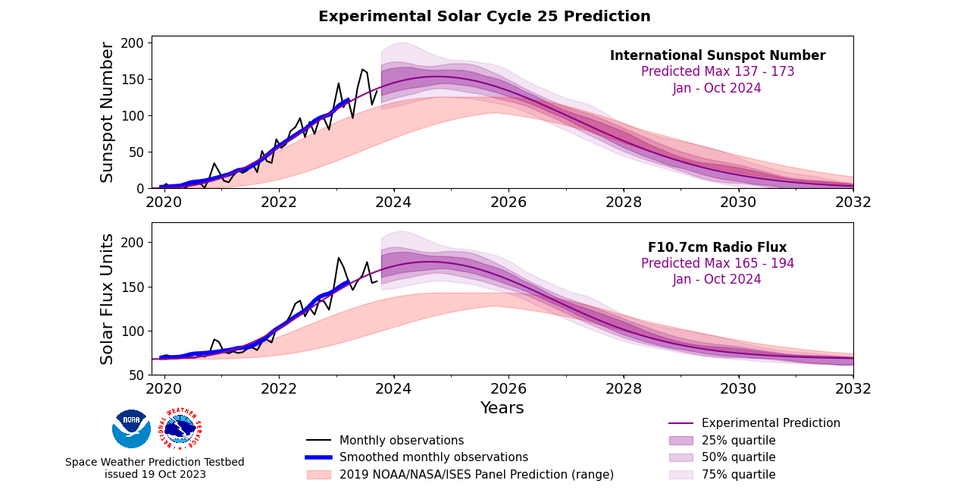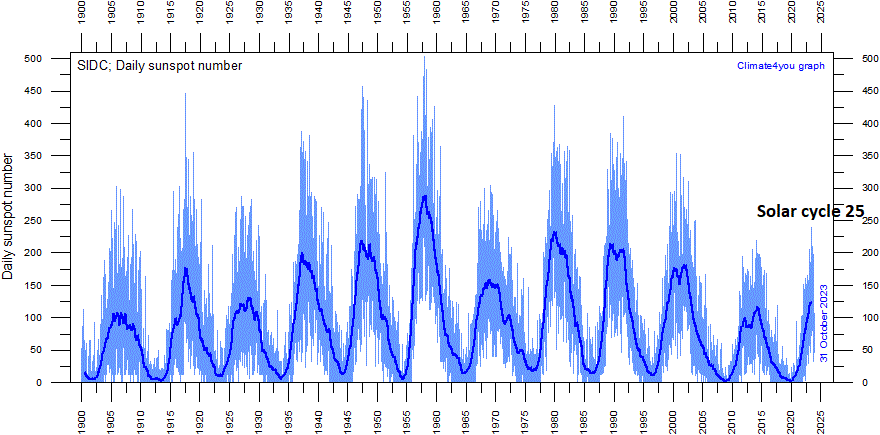7:15 AM | *Solar cycle 25 may peak earlier, be stronger, and last longer than previously expected…makes for an even better total solar eclipse in April 2024 and more frequent auroras*
Paul Dorian
The moon covers the sun during a total solar eclipse in Piedra del Aguila, Argentina, Monday, Dec. 14, 2020. A total solar eclipse provides viewers with a rare opportunity to see the sun’s outer atmosphere known as the corona and a more active sun will make for a more active corona. Credit for photo: AP (Natacha Pisarenko)
Overview
2024 was already going to be a very interesting year for sun observers in the US with a rare total solar eclipse visible on April 8th. In addition, it now appears that the current solar cycle 25 (SC25) may reach a peak sometime between January and October of next year which is much earlier than previously anticipated. The peak of SC25 may also be stronger and last longer than previously estimates.
This timing change of the maximum phase for the current solar cycle may actually make for an even better viewing experience of the total solar eclipse coming next April to viewers in the US. The reasoning is that a total solar eclipse provides a rare opportunity to view the sun’s outer atmosphere layer known as the corona and a more active sun will likely result in a more active corona. In addition, dazzling displays of the northern lights may become more frequent in coming months. Just this past weekend, two coronal mass ejections hit the Earth’s atmosphere and the double-blow sparked strong geomagnetic storms and auroras as far south as Texas and Colorado.
NOAA’s Space Prediction Center’s revised Solar Cycle 25 prediction. Image credit: space.com, NOAA
Revised prediction of the solar maximum phase for current cycle #25
There was somewhat of a lull on the sun during a few weeks in October in terms of the number of sunspots, but that quieter stretch was just a temporary blip, and overall activity has picked up in recent days. In fact, there has not been a single spotless day on the sun during all of 2023 so far and only one such day took place last year as solar cycle 25 has become increasingly active as it heads towards a solar maximum. Previously, solar scientists at NOAA’s Space Prediction Center had predicted the peak of solar cycle 25 would take place in 2025, but there are now reasons to believe it will take place sometime next year and likely between the months of January and October. In addition, the peak in SC25 will likely be stronger and last longer than previous estimates that were made in 2019 which is when the current cycle got underway.
Daily observations of the number of sunspots since 1 January 1900 according to Solar Influences Data Analysis Center (SIDC) with Solar Cycle 25 seen at the far right in the plot. The thin blue line indicates the daily sunspot number, while the dark blue line indicates the running annual average. The recent low sunspot activity is clearly reflected in the recent low values for the total solar irradiance. Data source: WDC-SILSO, Royal Observatory of Belgium, Brussels. Last day shown: 31 October 2023. Last diagram update: 1 November 2023.
Predictions on when solar maximum will occur are based on long-term historical records of sunspot numbers, advanced statistics, and models of the solar dynamo - the flow of hot, ionized gases within the sun that generate our star's magnetic field which in turn drives the solar cycle. "We expect that our new experimental forecast will be much more accurate than the 2019 panel prediction and, unlike previous solar cycle predictions, it will be continuously updated on a monthly basis as new sunspot observations become available," solar scientist Mark Miesch recently said in a statement released by NOAA. "It's a pretty significant change." Also worth noting, despite solar cycle 25’s stronger than expected start, the cycle is still running historically weak in terms of sunspot numbers, and will likely conclude as such if its max does indeed arrive in the near future.
Monthly sunspot numbers of Solar Cycle 25 compared with the previous four cycles (current levels on green line indicated by arrow) [Source: solen.info]
Accurate predictions of solar activity are crucial as geomagnetic storms triggered by plasma outbursts known as coronal mass ejections can affect electrical grids, GPS signals, and can drag satellites out of orbit. In the last twenty years, the population of active satellites has ballooned to more than 7,000, with an additional 20,000+ pieces of debris larger than 10 cm. Losing track of so many objects in such a congested environment could theoretically trigger a cascade of collisions, rendering low Earth orbit unusable for years following an extreme geomagnetic storm.
Solar max and its potential (positive) impact on the upcoming total solar eclipse
If accurate, the revised prediction would actually be welcomed news for eclipse chasers as the total solar eclipse on April 8, 2024 would occur near the solar maximum. During totality, when the moon completely obscures the sun's disk in a rare occurrence, the sun's outer atmosphere known as the corona becomes visible to observers. During heightened solar activity, the corona is very active and eagle-eyed observers may be able to see solar prominences - gigantic loops of plasma extending outward from the sun - appear as bright pink spots at the sun's edges. The corona is always there, but we usually can’t see it because the photosphere is about a million times brighter and drowns it out. When the moon covers the sun's bright face, the corona is definitely the main attraction, and depending on location, the corona will be visible for up to 4 minutes 28 seconds in the upcoming total solar eclipse visible across much of the US.
The next few years will provide optimal conditions for some dazzling aurora displays. (Image credit: Space.com, Noppawat Tom Charoensinphon via Getty Images)
Solar max and its impact on auroras
During particularly strong space weather events - which are more common during solar maximum - Earth's magnetic field is disturbed, and geomagnetic storms can penetrate the magnetosphere and lead to widespread radio and power blackouts as well as endangering astronauts and Earth-orbiting satellites. One notable example occurred in 1989 when a CME accompanied a solar flare and plunged the entire province of Quebec, Canada into an electrical blackout that lasted around 12 hours according to NASA.
However, not all magnetosphere interferences are destructive, and one result in particular can be spectacular displays in the skies known as auroras. Specifically, the phenomenon is known as the northern lights (aurora borealis) in the Northern Hemisphere and the southern lights (aurora australis) in the Southern Hemisphere and is triggered by energetic particles being redirected toward Earth's poles and colliding with atoms of oxygen and nitrogen in Earth's atmosphere. Just this past weekend, two coronal mass ejections hit the Earth’s atmosphere and the double-blow sparked strong geomagnetic storms and spectacular auroras seen as far south as Texas and Colorado.
Auroras have intrigued humans for millennia with their wispy ribbons of light dancing across the sky. This spectacle is one of the most beautiful natural phenomena in the world and their occurrence is dependent on solar activity. The more active the sun, the higher the chance of vibrant auroras, and this is why we can expect more frequent sensational displays over the next few years.
Meteorologist Paul Dorian
Arcfield
arcfieldweather.com





